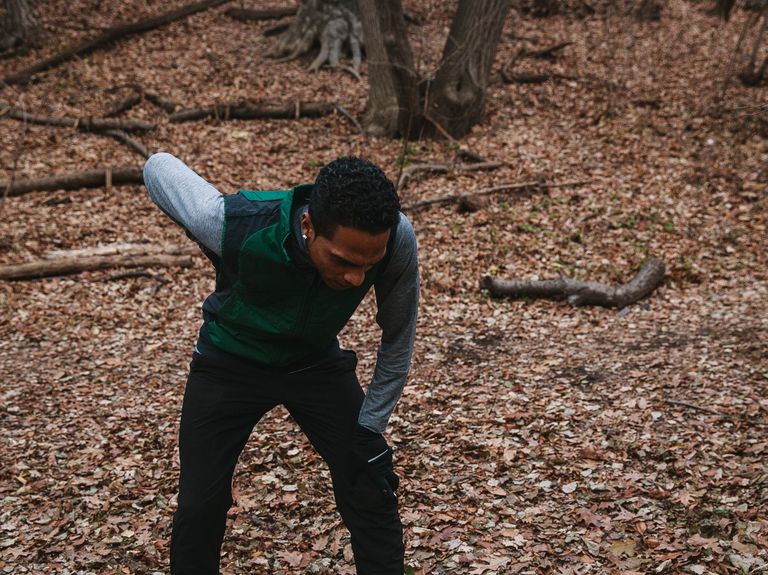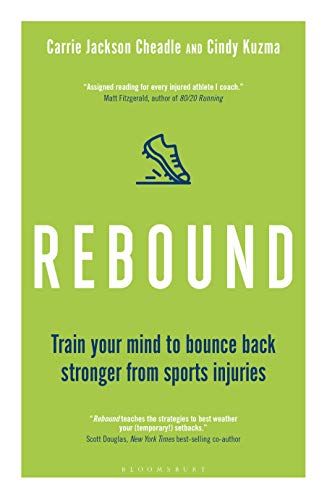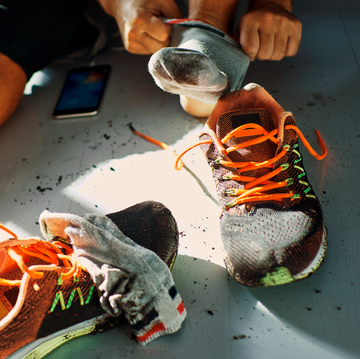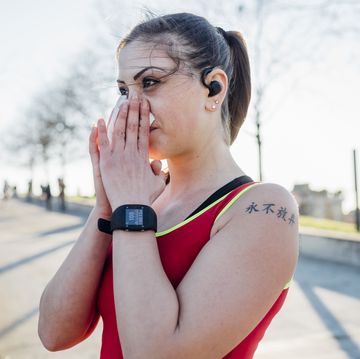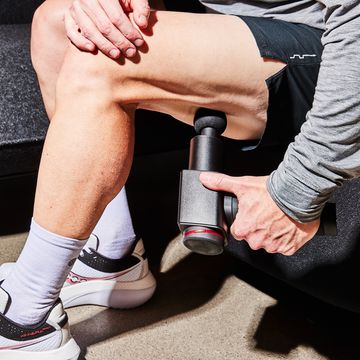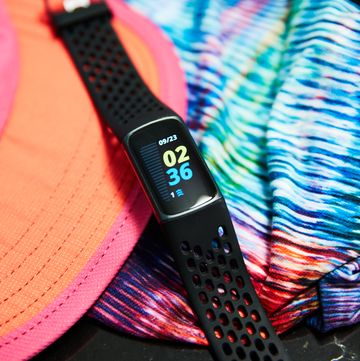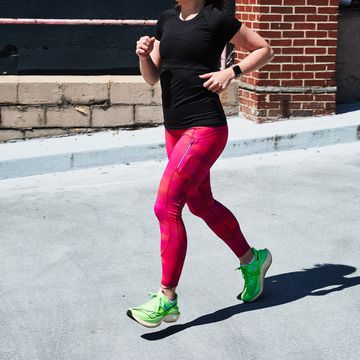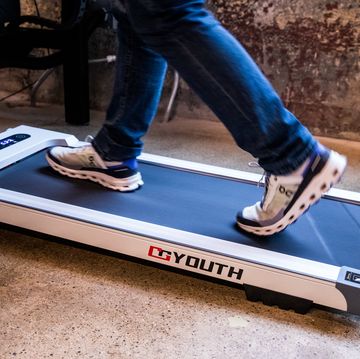The following was adapted with permission from Rebound: Train Your Mind to Bounce Back Stronger from Sports Injuries by Carrie Jackson Cheadle and Cindy Kuzma (Bloomsbury Sport).
The day after her crash, doctors told British triathlete Fiona Ford her marathoning days were likely behind her. On June 23, 2012, she was riding back home from a 50-mile training ride in the picturesque Surrey Hills when a car pulled out into a busy intersection. She and her bike both went flying. The impact of landing cracked her helmet, ripped the bike from under her, snapped her collarbone, fractured her sacrum and several vertebrae, and shattered her pelvis.
As she healed, Ford applied the same diligence that had made her a two-time world champion triathlete to her rehabilitation. The goals stayed small for a while. The first day, she was thrilled to wiggle her toes. A few days later, she focused on shuffling three feet from her hospital bed to the door. (It took 20 minutes, more than three minutes longer than her personal-best 5K time.) By the time she went home 10 days later, she had mastered crutching well enough to climb the 13 steps into her apartment.
Ford built the same type of structure into her days she’d use when training, replacing runs with slow walks, swims with hydrotherapy, strength sessions with rehab work. Her detailed training log included notes on doctor’s appointments, pain levels, and surgeries. Sure, she was using different metrics—moments of mobility instead of distance, wattage, or heart-rate intensity—but if she tracked them, she could easily see how she was making progress.
When Ford encountered a setback, she didn’t panic, but instead evaluated what went wrong and addressed it. For instance, she went back to coaching swimming—from a seat on the pool deck—for the first time a month after her accident. Afterward, she endured days of exhaustion and extreme pain. Recognizing she’d overreached, she waited about a week before trying again—and built in extra recovery time afterward.
At first, Ford didn’t obsess about the idea of competing again. Slowly but steadily, she regained her ability to swim and cycle, then run. At the last minute, she lined up at the starting line of the Windsor Triathlon in the summer of 2015. She led her age group the entire race, winning it by 12 minutes and placing seventh overall. Next she tried a half Ironman in Barcelona, then Ironman Maastricht; even though she broke her toe coming out of the swim, she did well enough to qualify for the Ironman World Championships in Kona, Hawaii, that October.
As she neared the final mile of the 140.6 miles she’d cover in Hawaii that day—Ironman features a 2.4-mile swim, 112-mile bike, and 26.2-mile marathon—a man on a bike tracking a different athlete told her she’d passed enough women in her age group to earn a podium spot if she maintained her pace. “The penny dropped on the enormity of what I just delivered on that day. As I headed to the finish line, I can’t tell you what the emotions were; it was just phenomenal,” Ford said. She finished in 10:46:53—about two minutes faster than she’d completed the same course nine years prior, at age 37—and placed third among women age 45 to 49. “It has totally redefined, in my mind, what’s possible for anyone.”
The Most Critical Mindset Shift for Injured Athletes
Before you got hurt, you had goals: Run your fastest marathon, win a state title, earn the coveted spot on an Olympic team. These ambitions keep you driven when you’re at the peak of your performance, and one of the most challenging aspects of injury is watching them slip through your fingers.
Though it’s often hard to wrap your head around when it first happens, you can tap into the very same drive during your recovery process by creating new goals and timelines. In being injured, you may have followed a path you didn’t intend to follow and your destination may not even be exactly the same as it was before, but ultimately, you are still on an athletic journey.
One of the most severe consequences of injury is the loss of identity, the sense that you’re adrift and purposeless without the training or competition to which you’re accustomed. But it’s possible to reframe your circumstances, to apply the very same athletic identity and approach you used in training and competition to recovering from your injury.
This type of response seems to come almost naturally to certain athletes. But mindset isn’t entirely predetermined by genetics or even by how your parents raised you. Just like you can go to physical therapy to strengthen and repair muscles, tendons, and joints, you can work on your mental skills to improve your injury experience.
Doing this can often allow you to regain as much of your previous skill, abilities, and functionality as you can, or even to surpass your past performances. Remember: You are still an athlete, and your recovery is now your sport. It’s an idea that seems simple—but has the power to restore the sense of purpose to your life.
“My greatest source of strength when the chips were down was applying principles from a previously active, athletic life to a recovery process without frustration that I couldn’t train or wasn’t racing,” Ford said.
Charting a New Course
Centuries ago, before the invention of the compass, before radar, before you could simply plug an address into Google Maps on your iPhone, explorers traveling by sea figured out which way to direct their sails by looking up into the sky and finding the North Star. Once they spotted the bright, shining glow of Polaris, they had their bearings; they were no longer lost. They knew which direction to steer the ship.
As an injured athlete, it’s common to feel like you’ve lost your North Star. You simply don’t feel like an athlete anymore—and therefore, you’re unsure how to navigate the world around you. How do you approach each day? It’s not clear how to fill the hours that used to be consumed by conditioning, strength training, logging mileage, and competing. You’ve likely had to put the major goals that once consumed you on hold, sometimes for an uncertain period of time.
Research shows us that one of the biggest challenges you’ll face as an injured athlete is dealing with the feeling that you have lost a part of yourself and your identity. At times it can feel like you’ve been completely cast aside. You’re sidelined, and therefore must acquiesce and wait it out until you are capable of producing, able to use your body athletically again. Even if you’re still training or participating in some capacity, you’re likely unable to perform at your peak, an experience that can be just as threatening to your concept of yourself as an athlete as not being able to participate at all.
This, in turn, can change your entire idea of who you are and what you have to offer the world. As you’ve likely already realized, the emotional shifts that come with injury can affect your life far beyond the gym, path, or track.
Don’t Stop Now, Goal-Getter
Simply understanding the fact that you’re still an athlete, just one at a different point in time, has tremendous power. But of course, there’s a lot more you can do to put this notion into practice. The first step is to let go of your old goals and create new ones.
Sometimes this is part of your grieving process—letting go of what you originally hoped and dreamed you’d accomplish, or at least, the timeline along which you’d planned to do so. Consciously adjusting your goals and shifting your focus to your optimal physical and mental recovery helps you find your North Star again, reassuring you that you are no longer lost.
The Grab Your Goals exercise at the end of this article will help you hone in on your specific goals. Examples might include:
- goals for your physical rehabilitation, such as spending a certain amount of time completing your exercises
- mental training goals, such as daily mindfulness or meditation training or practicing visualization
- lifestyle goals that can affect recovery and performance—say, sleeping more or changing your diet
- increasing your knowledge of sport by reading or studying
- new performance or competition goals that take into account the probable timeline for your recovery (best set in cooperation with your medical and coaching team)
Before you even get to the nitty-gritty of setting your new goals, it’s helpful to understand some broad concepts. A goal needs to identify what you want to achieve and how you’re going to achieve it, and getting there requires an effective goal-setting strategy. Clearly defining your targets will help you direct your energy and efforts, keep you involved in your progress, and turn your focus toward aspects of your recovery that are in your control. Again, it might seem hard to believe at first, but following these principles can make your new goals just as meaningful—if not more inspirational and rewarding—than the ones you’ve had to release.
To follow the rules of good goal-setting:
Be specific. As a finely tuned athlete, you need more than general intentions—the more specific you are with your goals, the more likely you are to achieve them. Describing exactly what you are trying to accomplish, giving yourself a timeline for when you want to accomplish it, and having a game plan for how you’re going to do it are all good ways to get specific—covering the what, when, and how. If you’re too general with your goals, you’ll still be a bit afloat, with no map, process, or timeline. Often, people feel they’re failing at their goals—when actually, they’ve overlooked this part of the goal-setting strategy.
Create accountability. When you’re healthy, your coach might review your training log, and your teammates (and your Strava followers) certainly know when you’re training. Anything you can do to recreate this type of accountability when you’re injured will help you achieve your new goals. Some of this occurs naturally if you’re working with an athletic trainer, physical therapist, or other medical professional—but still, you’ll have plenty of work to do on your own. How can you build in some of this reinforcement and responsibility to your rehab? Some ideas:
- Sharing your goals, either verbally or on social media
- Writing them down in a journal or log
- Tracking your progress toward them
- Recruiting a goal buddy
Continue fine-tuning. Setbacks are an inevitable part of any goal path, but especially for goals related to injury recovery. The trajectory of your physical and mental recovery will not move strictly in an upward linear path. There will be ups and downs; the ability to recognize these moments and adjust your goals is an essential skill to have. Try not to think of your goals in terms of all-or-nothing, or that changing them in the face of new information or experiences means you have failed. Adjusting your goal is a normal and essential part of the process. The risk in not modifying your goals is that you give up on the goal altogether or you push too hard because you’re being stubborn, insisting on staying on the original course—and ending up setting yourself back further.
Identify obstacles. As we’ve just discussed, the path to your new goals isn’t always smooth and clear; you might encounter some fog or choppy waves. If you think through your route ahead of time, it’s likely that you can predict many of the potential obstacles that could interfere with your ability to accomplish these goals. Don’t stop there, though—for each obstacle, come up with a game plan for how you want to respond should it arise. Planning ahead in this way actually primes your nervous system to respond with less alarm and more confidence should you hit that particular bump in the road, enabling you to seamlessly implement the plan. Psychologists call this technique “mental contrasting.” If you’ve thought through—and perhaps even visualized—your responses in advance, your future self won’t have to spend time worrying and figuring out what to do while in a highly emotional moment. You already know exactly how you’ll react to the situation.
Celebrate accomplishments. When you achieve a major goal in your athletic career, the celebration comes almost naturally—you receive glowing headlines, congratulations from your family and teammates, a chance to compete at the next level. One key to making your adjusted goals feel just as significant, so you’re equally driven to achieve them, is to make sure you’re really reveling in your triumphs. Each time you achieve one of your new goals, tell your athletic trainer or physical therapist how proud you are, whether the step you’ve reached is getting back on a bike or just getting through a tough set of exercises. Share your success with your teammates, post it on social media (you can share it in the Injured Athletes Club on Facebook), or mark it with a gold star in your training and rehab log. Do whatever it takes to make you feel like you’ve really and truly accomplished something special.
Now that you understand the fundamentals of good goal-setting, you can start thinking about your new targets. Once you narrow it down, you’ll begin finding your true north again. Your North Star is still there, but the conditions have changed, and you have to adapt. It can be hard for your ego, which responds to your more primal urges, to make this shift, as it wants to continue to gauge your feelings of success (and failure) based on your original destination, based on the original course you set. It’s up to your higher brain to redefine what it means to be successful and adjust your goals accordingly.
Much like the clamshells or band walks you’re assigned in physical therapy, psychological exercises—we call them “mental drills”—can facilitate these types of mindset shifts. Here are two that aid in viewing recovery as your sport. You can try them when you're first hurt, and repeat again anytime you feel stuck or unmotivated.
Mental Drill: Redefine Success
List and celebrate other ways to “win.”
One of the many challenges of recovering from injury involves dealing with the temptation to define your current feelings of success in terms of what your body was capable of doing before you were injured. You might not have exactly the same goals now, but you can still find “wins” to celebrate, key milestones in your recovery. To get started with your celebration list, answer the following:
- What are your “firsts”? (For example, when you are weight-bearing, when you can walk, the first time you get back on the bike, etc.)
- When are the times you’ve demonstrated perseverance and resilience?
- Who are the people you’re grateful for?
- What are all of the things you are proud of?
- In what ways do you feel you are becoming stronger?
Also, come up with real ways of celebrating these wins—give yourself a special treat like a new piece of gear, post a social-media message, arrange a get-together with good friends (and maybe some cake). Make it truly feel like a worthwhile accomplishment, and you’ll find you have even more motivation to go for the next goal.
Mental Drill: Grab Your Goals
Set new physical, mental, and motivational targets to shoot for during recovery.
Setting deliberate goals for your injury rehabilitation and recovery will help you shift your focus to something in your control, offer an opportunity to redefine success, motivate you to work on your rehabilitation, and boost your confidence as you see progress. On your own or together with your rehabilitation team, identify targets you’re working toward. Then, get specific with your goal-setting, writing out your objectives, a timeline, the resources and support you’ll need, your strategy for accomplishing your goal, and how you will know if you are on the right track. Remember: You are still an athlete, and recovery is now your sport. Use the questions below to list out your new athletic goals—and update them with new ones as you accomplish each set.
- What’s my objective?
- When do I want to have this goal accomplished?
- What supplies/resources/support do I need to accomplish this goal?
- What specific strategies will I employ to accomplish my goal?
- How will I know if I am on the right track with my progress?
Get more mental skills for navigating injury—including more than 40 additional mental drills—in Rebound: Train Your Mind to Bounce Back Stronger from Sports Injuries. Copyright 2019 by Cindy Kuzma and Carrie Jackson Cheadle. Reprinted with permission from Bloomsbury Sport.

Cindy is a freelance health and fitness writer, author, and podcaster who’s contributed regularly to Runner’s World since 2013. She’s the coauthor of both Breakthrough Women’s Running: Dream Big and Train Smart and Rebound: Train Your Mind to Bounce Back Stronger from Sports Injuries, a book about the psychology of sports injury from Bloomsbury Sport. Cindy specializes in covering injury prevention and recovery, everyday athletes accomplishing extraordinary things, and the active community in her beloved Chicago, where winter forges deep bonds between those brave enough to train through it.
